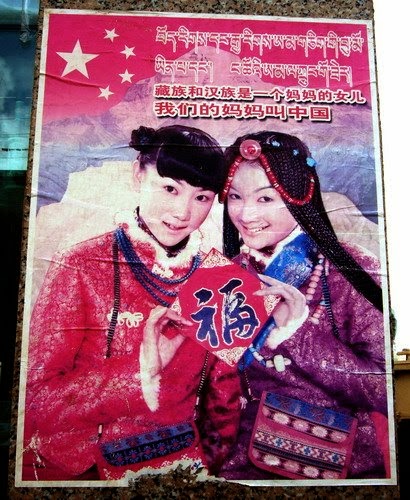
High Peaks Pure Earth has translated a blogpost by Woeser written in December 2014 for the Tibetan service of Radio Free Asia and published on her blog on April 1, 2015.
The blogpost follows on from previous posts about the situation in Inner Mongolia. The PRC’s ethnic policies are scrutinised as well as the changing linguistic terms being used in Chinese to describe ethnic groups by scholars and anthropologists.
The Intention Behind Changing “Nationality” into “Ethnic Group”
By Woeser
 Not long ago, I read the Chinese version of “Genocide on the Mongolian Steppe” by Yang Haiying, a Professor for Mongolian Studies at Shizuoka University, Japan. It was translated by Liu Yingbo and his daughter Liu Yanzi who live in China and Japan, respectively. This book, just as Wang Lixiong wrote in the preface, “should be a must-read for all Han Chinese”. The CCP’s many policies and movements, including the Cultural Revolution, the Great Western Development Program, and the various measures for “stability maintenance”, “will eventually lead to the escalation of the Mongolian problem in the same way as it has already happened in Tibet or Xinjiang.”
Not long ago, I read the Chinese version of “Genocide on the Mongolian Steppe” by Yang Haiying, a Professor for Mongolian Studies at Shizuoka University, Japan. It was translated by Liu Yingbo and his daughter Liu Yanzi who live in China and Japan, respectively. This book, just as Wang Lixiong wrote in the preface, “should be a must-read for all Han Chinese”. The CCP’s many policies and movements, including the Cultural Revolution, the Great Western Development Program, and the various measures for “stability maintenance”, “will eventually lead to the escalation of the Mongolian problem in the same way as it has already happened in Tibet or Xinjiang.”
Over the past few years, as Yang Haiying wrote in the epilogue to his book, “Chinese ethnologists have spared no efforts to push for policy change,” for example, to establish new theories tailored to the ethnic conflicts of modern times. I feel that some of the most important points put forward in his book are worth introducing in more detail.
In around 1990, Chinese ethnologists and ethnic theorists secretly changed the word “nation” (minzu) into the less politicised term “ethnic group” (zuqun). They believed that in doing so, they were taking preventative measures against any more severe threats of national separatism. Especially after the 2008 protests in Tibet and the 2009 incidents in Xinjiang, a growing number of Chinese scholars, including liberalists, supported the motion put forward by Chinese anthropologist Ma Rong who called for the abolishment of ethnic divisions and ethnic autonomous regions. Ma Rong had already published an article titled “A New Perspective to Understand Ethnic Relations” in 2004. In fact, it is all part of a larger scheme.

- Ma Rong giving a talk titled “Problems and Solutions Concerning China’s Ethnic Minority Groups” at the Graduate Center for Tibetan Studies of Sichuan University on May 25, 2009.
In this article, Ma Rong offers direct advice to the CCP, stating that the term “nation” (minzu) as used in “the Chinese nation” (中华民族) is fundamentally different in essence and meaning from the term “ethnicity” (minzu) as used in “China’s 56 ethnic minorities” (五十六个民族). Also, the internationally used term “nation” has clear and distinct political implications, relating to national self-determination and sovereignty. “Ethnic groups” on the other hand, are characterised by distinct cultural traditions and histories; they are no political entities and possess no stable territory. Accordingly, referring to China’s 56 ethnic minorities as “ethnic groups” is a means to depoliticise them, preventing any hidden dangers of national separatism and eventually realising the endeavour of creating ethnic identities within the broader “Chinese nation”, instead of political identities among individual ethnic groups.
Yang Haiying criticises this by arguing that if the terms “Mongolians” or “Tibetans” are replaced by the notion of “Mongolian ethnic group” or “Tibetan ethnic group”, it would in turn mean that Mongolians in China who were originally “part of and related to a sovereign ‘nation’ and shared the same beliefs, cultural traditions, historical memory, and economy based on the raising of livestock with their fellow Mongolians in the sovereign Mongolia… will through this be degraded to second-class slave-like citizens under the rule of the Chinese.” So, as Yang Haiying writes, “the ‘theories’ of these scholars are actually ‘helping’ and ‘serving’ the CCP’s authoritarian dictatorship.”
December 2014





Follow Us!